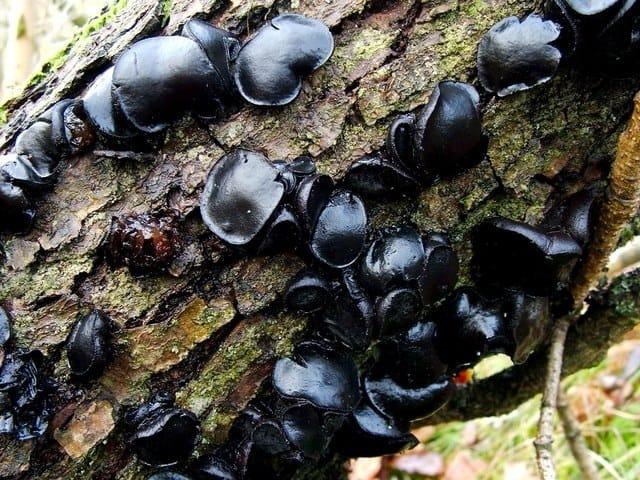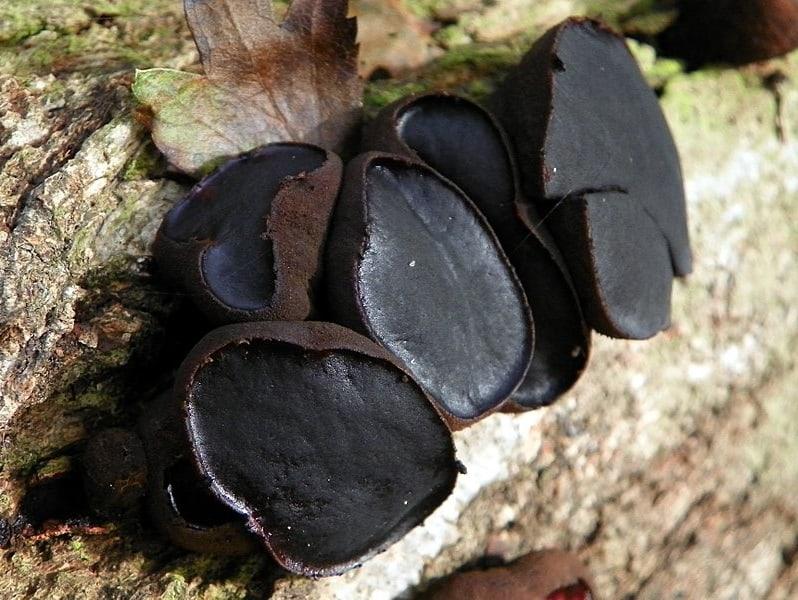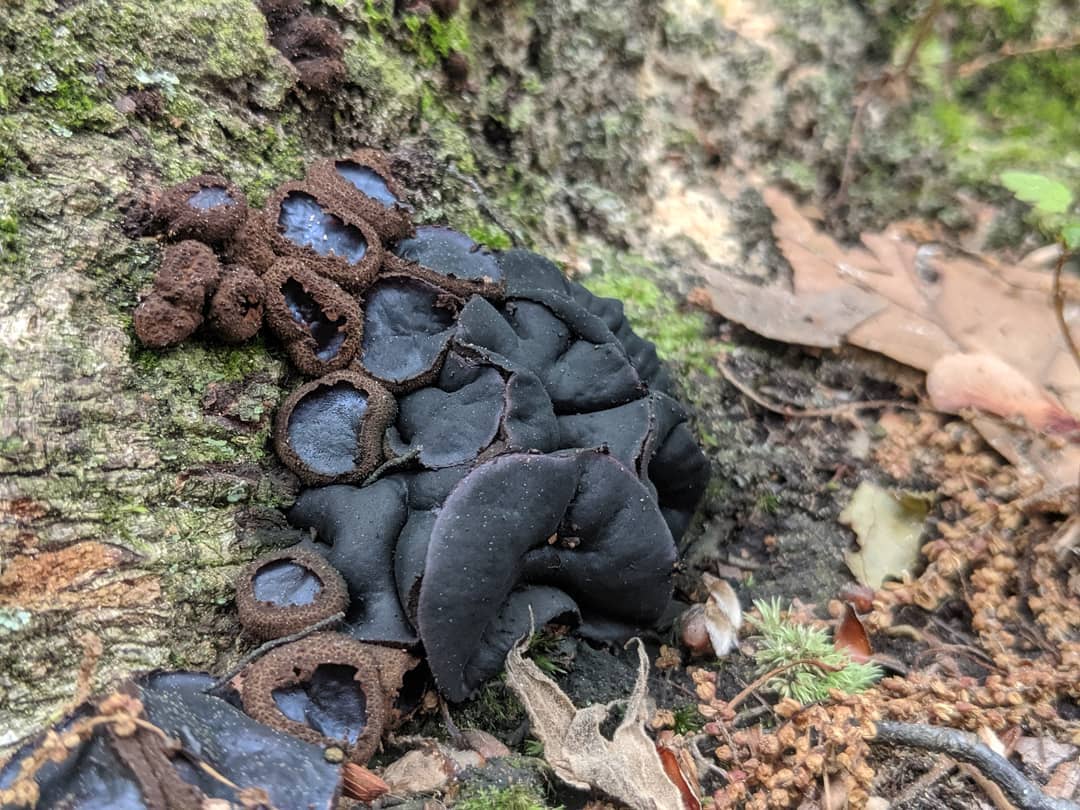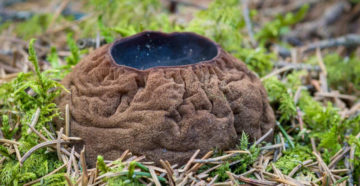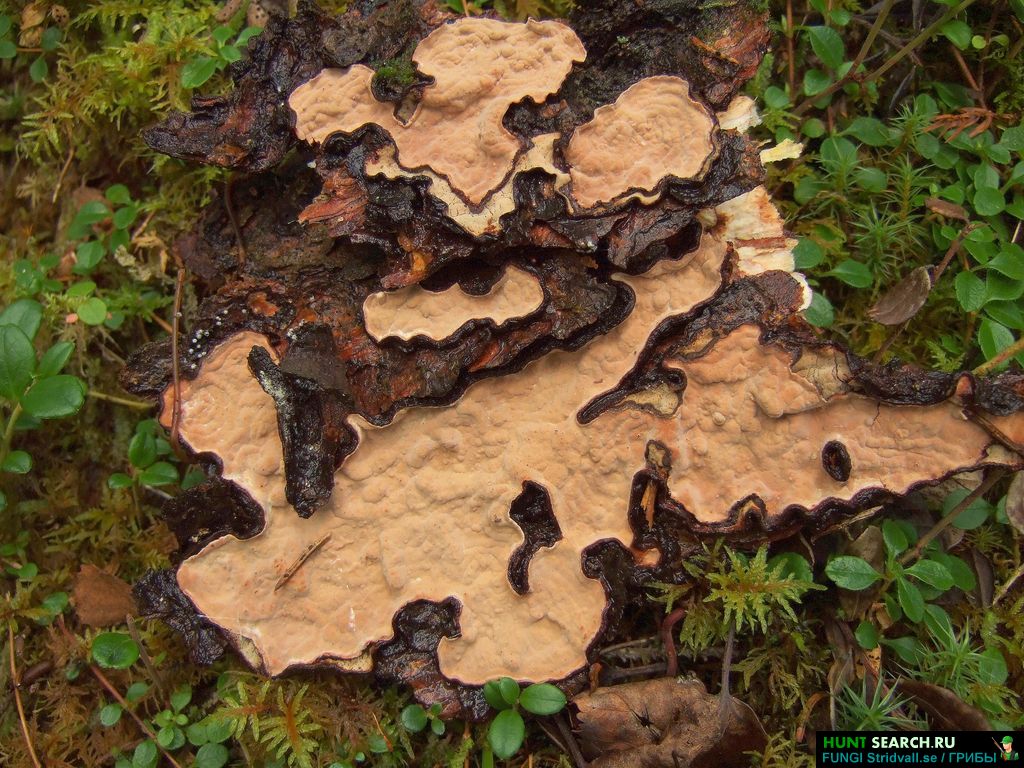Bulgaria Inquinance
Bulgaria inquinans - lat. (Bulgaria inquinans)
In another way, this mushroom is called staining Bulgaria.
Description of the mushroom
Fruiting body
The diameter of the fruiting body reaches 10-40 mm, the height is 20 mm. Young fungi have a rounded, closed body, resembling a plaque, and held on a tiny stalk no more than 3 mm long. The rough surface of the young body is covered with tubercles and is colored ocher-brown, brown or brown-gray. The tubercles are brown - purple or brown in color.
Subsequently, in the center of the mushroom, reaching the edges, a pit with a blue, almost black bottom is formed. The mushroom itself becomes like a glass or a depressed pot, which turns into a saucer with old age.
At the top of the staining Bulgaria there is a glossy disc that turns brown - red, bluish - black, and then - in olive - black tone. On fine days, it remains smooth and dull, in rainy weather it damp and shines. Old mushrooms shrivel and dry out.
The mushroom is filled with a jelly-like, tight, ocher-brown flesh that exudes a pleasant mushroom aroma or does not smell at all.
Bulgaria Inquinance reproduces by black-brown smooth kidney-shaped spores contained in black spore powder. They are abundantly isolated from mushrooms and stain the nearby soil in a black-brown hue, for which they were called dirty.
Growing places
For growth, the fungus chooses dead wood and other remains of oak, aspen, birch, beech and other trees located in mixed and deciduous forests, in park areas. Prefers shaded areas and appears in large numbers after rains. Often found in North American and European countries.
Group fruiting in Bulgaria, which stains, depending on climatic characteristics, falls on July - November.
Edibility
Although a pleasant aroma often emanates from this mushroom, Bulgaria is not eaten because of its specific type and tasteless pulp.
Similar types and differences from them
Bulgaria Inquinance can be confused with the following inedible species:
- The exidia is truncated. Prefers dead oak branches and grows in crooked black fruiting chalk.
- The sarcosoma is spherical. It differs in less group fruiting (no more than three fruiting bodies are combined together) and chooses coniferous forests for growth.
Healing properties
This Bulgaria contains many sugars, quinones, proteins and specific lactones, as well as fatty acids (oleic, palmitic, oxalic, phthalic, etc.) and eighteen amino acids. Thanks to such a rich composition, this mushroom has a lot of medicinal properties:
- Suppresses the growth of cancerous tumors. For example, sarcoma-180 cells are destroyed by 60 percent of the mushroom extract. At the same time, immunity decreases slightly, in contrast to the use of chemotherapy, which kills a lot of healthy cells.
- Improves the rheological parameters of blood cells. Due to some diseases, blood does not move well through the vessels, blood circulation is disturbed, the blood thickens, the shape of erythrocytes is disturbed. The alcoholic extract of the mushroom improves the condition of blood cells and the speed of their movement through the vessels.
Despite the presence of these medicinal properties, Bulgaria Inquinance is not recommended for treatment during pregnancy and lactation.
Evaluation of the edibility of staining Bulgaria
Bulgaria staining has a tasteless pulp, therefore this mushroom is classified as inedible.

Medicinal properties of Bulgaria Inquinance
According to studies carried out in 1993, Bulgaria Inquinance has an anti-cancer effect. Water and alcohol extracts from these mushrooms, when properly dosed, have a cytotoxic effect on the tumor. The studies were carried out on mice.
The alcoholic extract stops the development of sarcoma 180 in mice. These fungi were 50% effective against transplanted tumors.
In addition, Bulgaria staining regulates the immunological function in animals, while chemotherapeutic agents do not give such an effect and, moreover, provoke side effects and poison the body. This is manifested in the fact that the wool of animals after taking the drugs noticeably thinns and stops shining, and after taking the extract from the mushrooms, the wool does not deteriorate, in addition, the body weight is maintained normally.

Also Bulgaria Inquinance influences the rheological parameters of blood. The development of many acute and chronic diseases lead to disturbances in the ability of blood to move through the vessels: the viscosity increases, the integrity of the plasma is disrupted, and the aggregation of erythrocytes increases. It has been experimentally proven that the alcoholic extract of these mushrooms has a positive effect in reducing the deformability of erythrocytes.
Aqueous extract of staining bulgaria affects the deformability of erythrocytes. The positive effect is also manifested in a decrease in the erythrocyte sedimentation rate.

Interesting facts about the mushroom
- According to some scientists, globular sarcosoma is able to fight cancer cells.
- In some sources, sarcosoma is referred to as an inedible mushroom species. But in some regions of Russia it is fried or stewed with potatoes. The dish is called "sarkosomnik".
- It is believed that a rich cam crop can be harvested no more often. than once every 8-10 years. It is with such a frequency that the mushroom throws out fruiting bodies.
- Earth oil has a unique composition that can treat a wide variety of diseases, even cancer.
Sarcosoma is a mushroom, not only rare in prevalence, but also extremely useful. Not knowing what it is and how to use it, you can walk by without risking putting it in the basket. Having an idea of its unique composition and properties, one would hardly want to miss the chance to improve one's health with the help of such a magnificent gift of nature.
Medicinal properties, recipes and methods of application
The mushroom is unique not only in its appearance, but also in its composition:
The use of Sarcosoma globular helps to solve many human health problems:

- It has a beneficial effect on the functioning of the brain. It is recommended to take "earth oil" daily on an empty stomach.
- Relieves fatigue. The inner content of the mushroom does not require special preparation. You just need to take mushroom mucus in small doses, which helps to strengthen the immune system, stabilize the state of the nervous system, and restore strength.
- Relieves diseases of the stomach and digestive organs. A medicinal drug will relieve the symptoms of gastritis and other diseases.
- Improves hair growth. The fruiting body fluid saturates the hair follicles with nutrients. It is necessary to rub it in a circular motion into the scalp.
- Smoothes wrinkles. The recipe is simple: the crushed walls of the fruiting body are diluted in a small amount of water and applied to the skin of the face and hands, like a mask.
- Joint treatment. Sarcosoma relieves problems with rheumatism, polyarthritis and other diseases.
False doubles
Spherical sarcosoma, like many other mushrooms, has its own kind in nature. And even though outwardly they are somewhat similar, there are significant differences in habitat and the possibility of eating.
More details are in the table and in the photo.
Bulgaria inquinans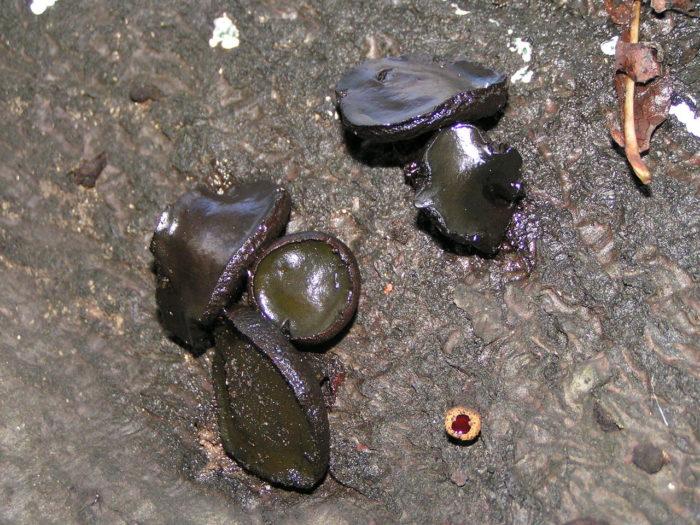 |
|
Bulgariella pulla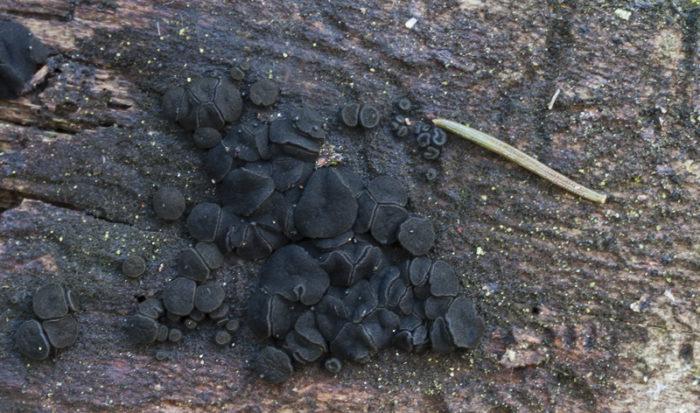 |
|
Bibliography
- Bao Haiying, Li Yu. Investigation of the nutritional composition of staining Bulgaria // Edible mushrooms of China. 2001.20 (6): 41-42.
- Bao Haiying, Li Yu. Investigation of the photoactivity of staining Bulgaria // Bulletin of edible mushrooms. 2002.9 (4): 15-17.
- Bao Haiying, Li Yu. Investigation of the chemical composition of staining Bulgaria // Systematics of mushrooms. 2003.22 (2): 303-307.
- Lijuguan. Edible, medicinal and poisonous mushrooms in northeastern China. Changchun: Northeastern Normal University, 1992: 23-56.
- Luxiaolong, Liuzhenqin, Lixiao et al. Isolation, cultivation and domestication of soil bulgaria // Bulletin of the Jilin Agricultural Academy. 2002.24 (2): 75-78.
- Chuidongbin, Wangshuqin, Dixiaokun. Investigation of the chemical composition of staining Bulgaria // Journal of Chinese medicines. 1997.22 (8): 485-486.
- Yuchunbo, Chenglin, Sonyu et al. Study of the conditions of artificial cultivation of soil bulgaria // Forest Science and Technology of Nrovition Jilin. 2002, 31 (3): 10-12.
- Yangxiaojing, Zhanghongwei, Sunhong, Zhangzhiwei, Kangbin, Zhangshuchen. Antitumor effect of staining bulgaria // Investigation of the specificity of local products. 1993.2: 9-11.
- Yangxiaojing, Zhanghongwei, Zhandavei, Wing, Zhangshuchen, Gaoguiqin, Wuqingshan. The influence of bulgaria staining animal blood on rheology // Chinese medicinal herbs. 1966.27 (6): 358-359.
- Edwards R.L., Lockett H.J. Constituents of the higer roling. Novel benzofluoranthenequinones from the fungus Bolgaria inquinans (Fries) // J. Chem. Soc: Perkin Transactions 1976: 2149-2155.
- Fen wick GA A Conidial Form of Bolgaria inquinans // Mycologist. 1992, 6 (4): 177-179.
- Stadler M., Akne H. Novel bioactive azaphilones from fruit bodies and mycelial coltures of the ascomycetes Bolgaria inquinans // Nature Product Lettfer. 1995.7 (1): 7-14.
Description of the mushroom
This species belongs to the ascomycete species, the sarcosomaceae family.
Although the mushroom is considered rare, it gives good yields during the fruiting season and subject to the necessary conditions of existence. From a small area of several square meters, a 12-liter bucket is quite easy to pick up.
The Latin name sounds like Sarcosoma globosum.

In addition to the official name, there are other, more common names by which the mushroom is known among collectors. Earthen oil, potato or cam - this is how mushroom pickers usually call sarcos among themselves. Popular nicknames arose on the basis of signs visible to the naked eye.
As such, the cam does not have a hat; it is replaced by a fruiting body, very soft to the touch. In shape, it resembles a crumpled ball or barrel, reaching 8 cm in girth, and about 5-10 cm in height. The older the mushroom, the more the barrel turns into loose and baggy.
From above, the cap is covered with hymenium - a thin layer of a substance containing elements of spores. With aging, the fungus decreases in size and the spore-bearing layer turns outward, as it were. A new hole appears in the center of the body, through which liquid then seeps out.
The peel of the earth oil feels like a velvet fabric. In young mushrooms, it is smooth, in more mature ones, it has noticeable folds.
The color of the sarcosoma is brown, sometimes brown, darker in the lower part.
The lower part of the cap, the hymenophore, is smooth, not pronounced.
The pulp on the cut is a gelatinous layer. It is formed in young mushrooms and separates the mucous fluid that fills the inner space of the fruiting body and the outer wall.
The leg is missing.
A bit of history
The first mention of mushrooms that outwardly resemble sarcosomes occurs at the end of the 19th century. The French scientist P. Karst in his writings described an organism characterized by a jelly-like body up to 3 cm in diameter.
In Russia, sarcosoma was first noted by scientists Sakulin and Soyuzov. The mushroom interested them not only in its unusual shape, but also because it was actively used in folk medicine as a treatment for rheumatism.
When and where does it grow?
Globular sarcosoma prefers to grow in an untouched coniferous forest among pines and firs. There are always a lot of fallen needles and an abundance of moss - the most attractive conditions for the mushroom.
Being a saprophyte, that is, an amateur to receive nutrients from dead plants and organic debris in the soil, sarcosome prefers to grow in dense grass. This makes it difficult to locate the fetus.
Organisms grow, though singly, but in colonies of 8-10 pieces. Sometimes populations can be even larger - more than a hundred fruiting bodies, and occupy a significant area - about 4,000 square meters.
The species has an arctic-alpine distribution. Sarcosomes can be easily found in regions of Siberia.In the middle taiga, they usually grow in mixed dark coniferous forests, in aspen or almost pure cedar forests. In Western Europe, it is found infrequently, in extremely pure, unalloyed spruce forests.
More often it catches the eye of mushroom pickers in Central Europe, especially in the region of Belarus, where the soil is rich in minerals.
Description of bulgaria incvinance
The fruit body is approximately 2 centimeters high. The diameter of the bulgaria, which stains, is about 1-2 centimeters, sometimes it reaches 4 centimeters. The fruit body is at first rounded, closed, almost plaque-like, while its diameter does not exceed 0.5 centimeters, then a small depression appears, tightened from the edges.

Later, the fruiting body becomes obverse-conical or goblet, depressed, but filled inside. In old age, the fruiting bodies become saucer-shaped, at the top with a blue-black or red-brown disc, which then becomes dark gray, almost black.
The color of the fruit body is gray-brown, ocher-brown with purple-brown or brown scales; over time, the surface becomes wrinkled, almost black in color. Old mushrooms dry out to a hard state.
The color of the spore powder is black. The pulp is gelatinous-elastic, fleshy, dense. The color of the pulp is ocher brown. The pulp may be odorless or, conversely, have a pleasant mushroom aroma.

The spread of the staining bulgaria
The fruiting of Bulgaria Inquinance occurs from September (after a cold snap) and continues until November. Bulgarians grow blotting on dead wood, on dead aspens, oaks and other trees. They settle in groups. This monotypic genus is rare.








